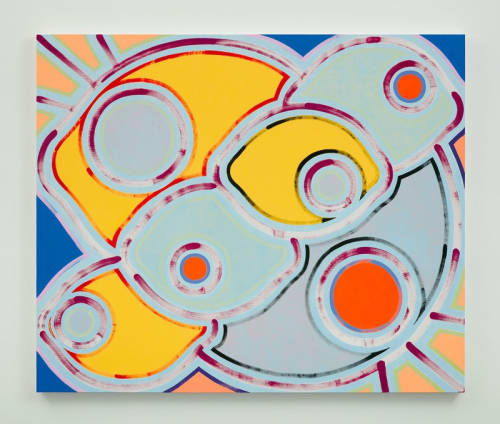Holly Coulis’s brilliant, punning title perfectly captures the intellectual conceit that drives her equally brilliant show. Her work, picking up on the eyes in the title, has always been a matter of focus. How, in her earlier paintings, to perceive a still life: should the size of objects in a painting be determined by reality or should size have nothing to do with representational verisimilitude? Her concept of painterly space was, literally, a space to be populated with shapes, and in that sense (and that sense only) was similar to that of, say, William Scott, who isolated domestic objects on a color field. But Coulis stepped aside from direct representation and either magnified or reduced her subjects according to how she happened to conceive them at that particular instant. Somehow, she could be holding up to them either a magnifying lens or a reversed telescope, all by way of whim.
So, while still life may have been her point of departure, she was never hemmed in by it, which is perhaps the best way to deal with tradition—it’s there, not to dominate but to be played with, parodied. Coulis rejects “the anxiety of influence” by reworking the past in her own image. At one level, this is the point of Eyes and Yous. These ten paintings and three sculptural objects take as their point of departure the perceiving eye. There is a recurring eye-shape in most of the works, so a Gestalt with links to a real world persists in her work, but, unlike the case of her still life paintings, it is now a ghostly presence. Coulis’s drift is toward abstraction but in the mode of a Bram van Velde, even toward his muted palette: by restraining color, she forces us to take in the entire composition of each work. We are not bedazzled or distracted by details.
Take After You (2021), one of two large, 60 by 70 inch oils on linen. Here, the eye concept is magnified to the point that the orb dominates the entire canvas, reminding us, again, of the shifting magnification in the still life paintings. Traversed by pinkish veins, the eye appears to be depicted as if seen from within the brain—that is, we seem to be looking through the eye. This is a phenomenology of seeing with almost surrealist intentions. On the wall opposite this impressive canvas is Ocean Eyes (2021), a more modestly sized 50 by 60 inch painting. The eyes are more discernible as eyes we can stare into, though, again, the vein-like lines both connect and separate the orbs, pushing the composition further into abstraction.
If Coulis’s paintings are characterized by a high level of intellectual humor, her three sculptural pieces veer more toward a playful commentary on the entire show. Vaguely anthropomorphic, they locate the act of seeing—a central issue here—in a hypothetical spectator. Sitting Painting (2021)—about twenty inches high—with its yellow “face” catches the visitor by surprise. The observer observed. Standing Painting (2021), about the same size, stands the spectator on his own two (geometric) feet and fixes us with three violet eyes. Sleeping Painting (2021), with its cocked head, seems to ask us, “Just what is it you think you are doing here?”
It seems that what we are doing is using these paintings and objects to think about the possibilities entailed in the act of seeing. At the same time that she deconstructs vision, Coulis enacts the philosophic principle that objects, including paintings, only exist when perceived. So, the act of seeing passes through several phases here. First, the peculiar, ever so transient instant when our gaze can actually be within the work. A flash, when we experience the work without assumptions, as pure experience. Then innocence dissolves, and we quickly interpret what we see according to our own sensibility.
But whatever we retain in memory is ours, because when we stop looking at it, the original disappears. At the same time, Coulis reminds us that our seeing is a mirror- image of her seeing, that the artist is simultaneously maker and spectator of her own work. Coulis makes us into participants in her process. No, we cannot be Holly Coulis, but we can certainly experience a renewed appreciation of the divine gift of seeing thanks to her work.

